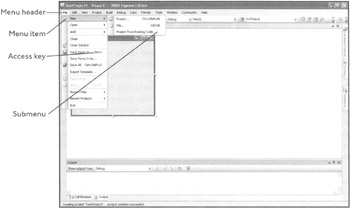DESIGNING A MENU SYSTEM
A menu system is one of the most standard features of any Windows application. Menus provide a compact way to organize the commands that make your Visual C++ applications work.
Menus are convenient because they save users space. Often, they take up only a single line at the top of many applications. In fact, they really only occupy space when activated. When a user finishes accessing a menu, it closes and returns control of the program to the user. This helps to free up valuable desktop space for other tasks.
Figure 4.7 shows a typical Windows application menu system. As you can see, it consists of many different features.

Figure 4.7: This menu illustrates the contents of the Visual C++ Express 2005 File menu.
Windows application menu systems generally consist of one or more of the following six menu features, each of which is visible in Figure 4.5. These six menu features include the following:
-
Menus. These are the first, or high-level, menu items that are immediately visible from the menu bar. Examples include File, Edit, and Help.
-
Menu items. These are additional menu items residing under menus, each of which represents a choice that users can make.
-
Submenus. These are collections of menu items accessed through a parent menu item. You can identify submenus by the black arrow on the right end of the menu item that provides access to them.
-
Shortcuts. These are keyboard characters, such as the F1 key, that can be used to access menu items.
-
Access keys. These are keyboard keys that, when used in conjunction with the Alt key, activate a menu or menu item.
-
Separators. These are horizontal lines used to organize menu items into logical groups.
Most users have enough experience with Microsoft Windows that they expect certain minimal standards from the applications that they use. They have come to expect that all Windows applications work in certain similar ways. Any application that fails to meet these expectations runs the risk of disappointing its target audience, no matter how well designed it might be. One major expectation that most Windows users have is that Windows application menus will perform the same way across applications. For example, users have come to expect to see menu headings such as File, Edit, and Help. The File menu, for instance, is generally expected to be first in the menu's list, and Help is often listed last. Options for opening, closing, printing, exiting, and so on typically are located on the File menu. The Exit command is expected to be the last menu item on the File menu. You should avoid upsetting this traditional expectation unless your application has an overriding need to do so.
EAN: N/A
Pages: 131